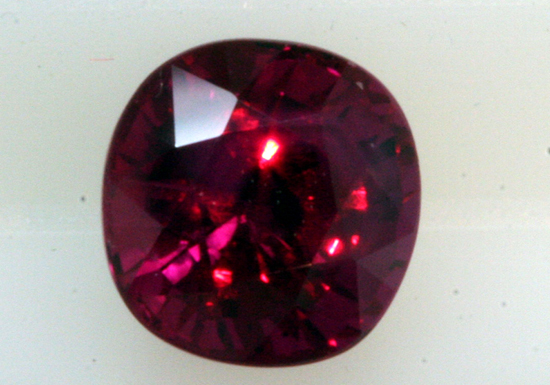What is Pigeon’s Blood Red, part 3
July 14th, 2009 by James L. Sweaney, CGA, FGA. GGWithin the gem trade, the color of the best rubies has for centuries been called “Pigeon’s Blood Red.” As mentioned in a previous blog, the term has actually become a grading term. Part of the way to understand this color is to know what it it not.

Nice 1.35 ct Burma Ruby, not quite Pigeon's Blood
For the most part, better rubies from Burma display this color or at least approach it. But, not all rubies from Burma are Pigeon’s Blood. Like any naturally occurring object, there is a normal distribution pattern that can be described by a bell curve– most examples cluster around the mean, while at either end of the curve, one has the worst, the other the best examples. In the gem business, we know that the very best quality gems are often less than 1% of the overall production. This 1.35 ct. Burma ruby has very nice color, a well balanced blend of violetish-red and orangish-red, but it lacks the clarity and the saturation to display the true Pigeon’s Blood color.
The chemistry of rubies from Burma is distinctive in that little or no iron present. In fact, rubies with little or no iron present are sometimes referred to as “Burma-type”. Part of the allure of Burma-type rubies is that they fluoresce a bright orangy-red in the presence of ultraviolet light. This touch of flourescence varies from moderate to strong, and “supercharges” the saturation level of the color.
Many of the rubies from Burma, particularly those from the newer Mong Hsu locale, are oversaturated with bluish or purplish secondary tones. Other less desirable Burma stones have too much pink, a color the Burmese refer to as “rabbit’s blood”. Some gem merchants would call these stones pink sapphire, rather than ruby (more about this distinction in a blog to follow). Vietnam has for several decades been producing similar hot pink sapphires and rubies that are very similar to Burma stones.
From the early 1960’s to 1991, Burma (Myanmar) was closed to the gem trade, so ruby production shifted to Thailand. Stones from Thailand contain trace amounts of iron which lends a slightly brownish cast to the red and quenches any flourescence. As a result, the Thai ruby has a more reserved appearance. The 1 3/8 ct. Thai ruby in the ring below is a very pleasant dark red with a very slightly brownish mask.

Nice 1 3/8 ct. Thai Ruby, modern Platinum mounting
In general, the Thai ruby has a somewhat different look and character than the Burma material. Many people became accustomed to the Thai spectrum of reds and prefer it to the “louder” red of Burma. Large fine Thai rubies are rare and desirable, as evidenced by the two rings below, values approaching six figures.

Fine 5 ct. Thai ruby, Harry Winston

Fine 6 ct. Thai ruby, Bayco
The market place tends to equate the best qualities with the most expensive stones, but in reality, all fine gems have their own unique character and beauty. It’s the eye of the beholder that makes them precious and desirable. This is called one’s own taste.
The process of developing taste, of becoming an aficionado of gems includes educating both one’s eye and one’s intellect. You can begin training your eye at our Gallery of Gems, and you can develop a rational approach to comparing one gem to another by reading our documentation of the Mardon system of grading colored gems.
Tags: Burma ruby, flourescence, Thai ruby







